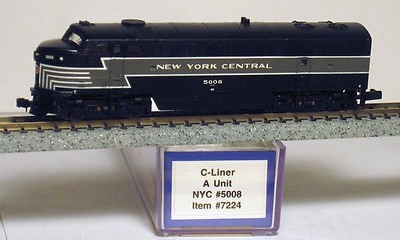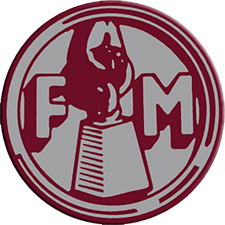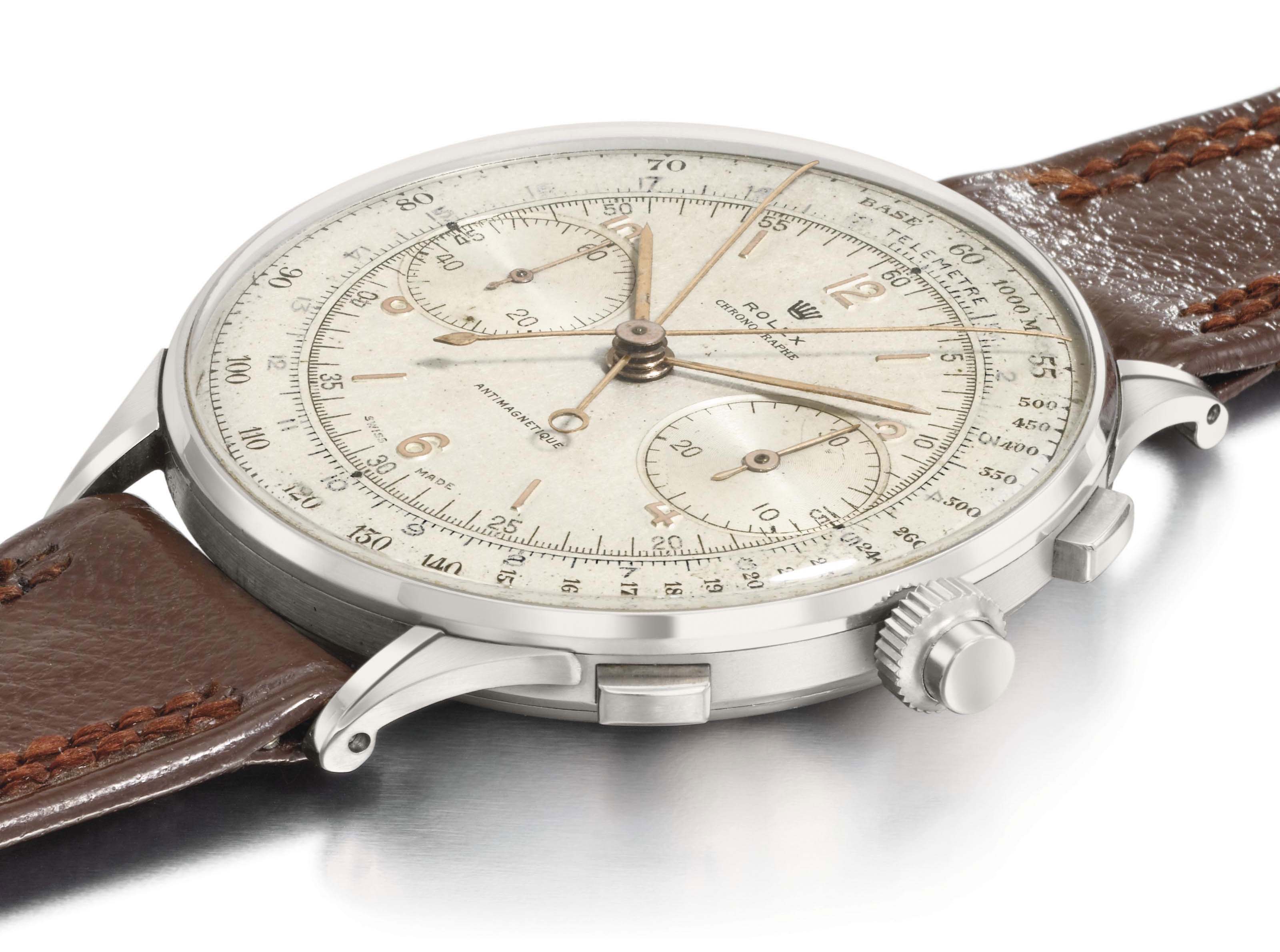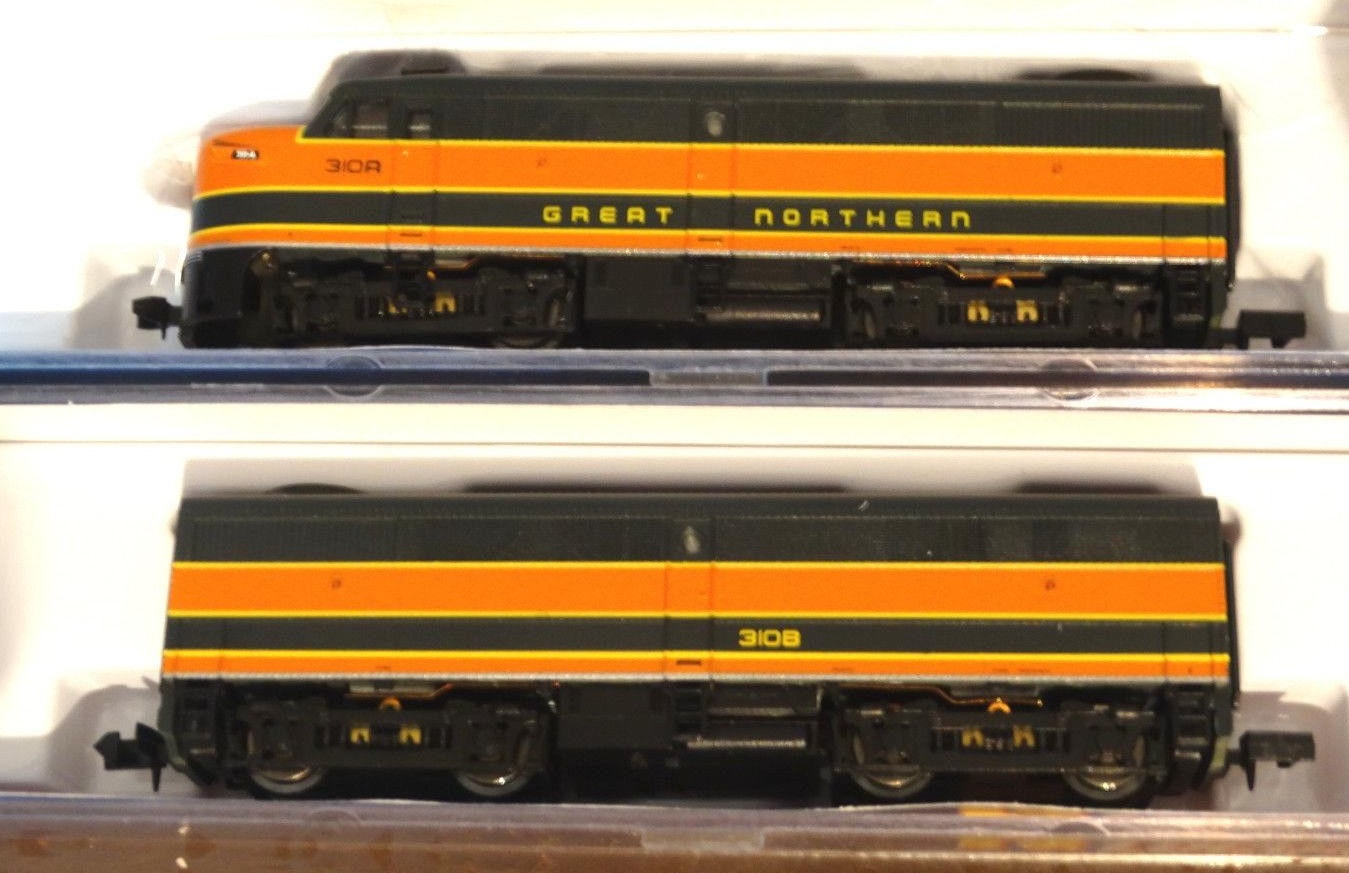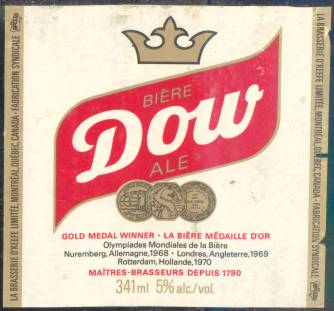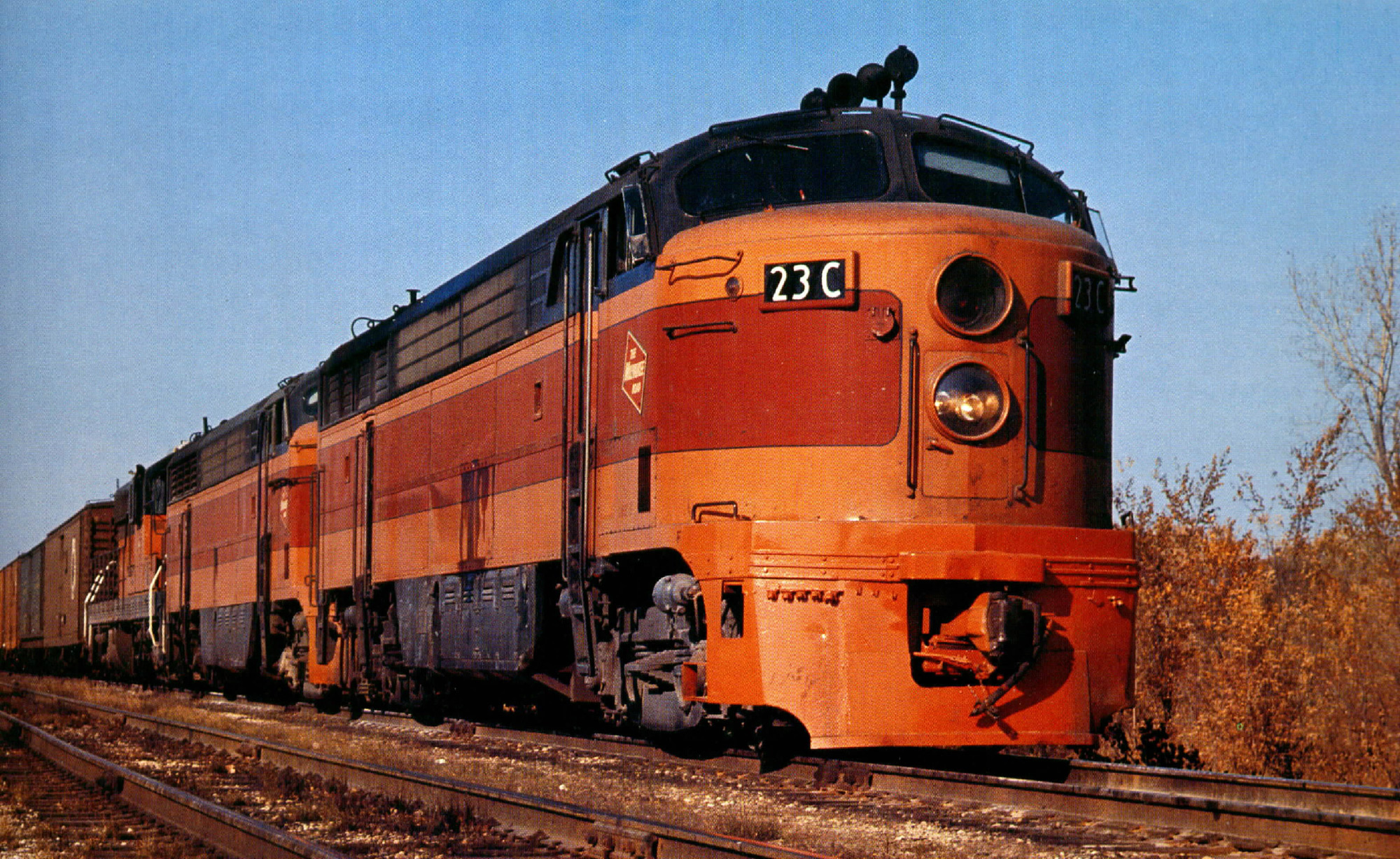Specific Item Information: CFA16-4+CFB16-4
Model Information: Model introduced in 2001 (with Rapido couplers and a dummy knuckle front coupler) and re-run in 2006 with Accumate knuckle couplers.
It re-used the same chassis structure introduced by Life-Like for its 2000 Alco FA-1/FB-1.
The 2001 run was sold in A/B pairs, both engines being powered. The 2006 run was available either in A/B pair or A singleton.
Features:
- Modern split-frame design.
- Directional LED Headlights on A units
- 8 Wheel electrical Pick-Up with Heavy Metal Chassis
- Five-Pole, Skew Wound Armiture motor w/dual machined flywheels
It re-used the same chassis structure introduced by Life-Like for its 2000 Alco FA-1/FB-1.
The 2001 run was sold in A/B pairs, both engines being powered. The 2006 run was available either in A/B pair or A singleton.
Features:
- Modern split-frame design.
- Directional LED Headlights on A units
- 8 Wheel electrical Pick-Up with Heavy Metal Chassis
- Five-Pole, Skew Wound Armiture motor w/dual machined flywheels
DCC Information: The initial run of 2001 had no provision for DCC. Examples of installation of a wired decoder are available on TCS website, as well as on N Scale DCC Decoder Installs blog by our fellow curator Brad Myers.
On the second run of 2006, the chassis was modified to become DCC-Ready with contacts available on a PCB. Would rather qualify as DCC Friendly, as some wiring is still required given the lack of choice of drop-in decoders for this model.
The only available drop-in decoder we have found is a sound decoder by MRC:
- MRC 1660: N Scale Drop in DCC Sound Decoder for Life-Like C-Liner Locomotive
On the second run of 2006, the chassis was modified to become DCC-Ready with contacts available on a PCB. Would rather qualify as DCC Friendly, as some wiring is still required given the lack of choice of drop-in decoders for this model.
The only available drop-in decoder we have found is a sound decoder by MRC:
- MRC 1660: N Scale Drop in DCC Sound Decoder for Life-Like C-Liner Locomotive
Prototype History: The Consolidated line, or C-line, was a series of diesel-electric railway locomotive designs produced by Fairbanks-Morse and its Canadian licensee, the Canadian Locomotive Company. Individual locomotives in this series were commonly referred to as “C-liners”. A combined total of 165 units (123 cab-equipped lead A units and 42 cabless booster B units) were produced by F-M and the CLC between 1950 and 1955.
The C-Liners replaced FM's earlier cab model the Erie-Built, which proved only marginally successful at best. The updated version of FM's cab locomotives did not feature a carbody nearly as elegant as the former, which sported a European look. It was offered for either passenger or freight (with four or five axles) service and intended to compete against Electro-Motive's (EMD) popular E and F series as well as Alco's FA and PA models. Unfortunately, the C-Liners saw about the same level of success as the Erie-Builts and FM canceled the line after only a few years of production.
All of the designs were based on a common 56 ft 3 in (17.15 m) carbody, but the customer could choose cab or booster units equipped with 1,600 hp (1.19 MW), 2,000 hp (1.49 MW), or 2,400 hp (1,800 kW) opposed piston engine prime movers. Each option was also offered in both passenger and freight configurations.
All freight units, and the CLC-built Model CPA/B-16-4 were designed with a B-B wheel arrangement, while passenger units (in addition to having different gearing) featured an unusual B-A1A wheel configuration, as the rear truck required an extra unpowered axle to help distribute the weight of the steam generator.
The models produced comprise: CFA-16-4 (cabs) and CFB-16-4 (cabless boosters), CFA-20-4 (cabs) and CFB-20-4 (cabless boosters), CPA-20-5 (cabs), CPA-24-5 (cabs), CPA-16-4 (cabs), CPA-16-5 (cabs) and CPB-16-5 (cabless boosters).
Using the CFA16-4 as an example the "C" referred to cab unit, "F" listed it for freight service, "A" was a designation for A unit, "16" was short for 1,600 hp, and "4" was the number of axles it carried.
From Wikipedia
Read more on American-Rails.com
The C-Liners replaced FM's earlier cab model the Erie-Built, which proved only marginally successful at best. The updated version of FM's cab locomotives did not feature a carbody nearly as elegant as the former, which sported a European look. It was offered for either passenger or freight (with four or five axles) service and intended to compete against Electro-Motive's (EMD) popular E and F series as well as Alco's FA and PA models. Unfortunately, the C-Liners saw about the same level of success as the Erie-Builts and FM canceled the line after only a few years of production.
All of the designs were based on a common 56 ft 3 in (17.15 m) carbody, but the customer could choose cab or booster units equipped with 1,600 hp (1.19 MW), 2,000 hp (1.49 MW), or 2,400 hp (1,800 kW) opposed piston engine prime movers. Each option was also offered in both passenger and freight configurations.
All freight units, and the CLC-built Model CPA/B-16-4 were designed with a B-B wheel arrangement, while passenger units (in addition to having different gearing) featured an unusual B-A1A wheel configuration, as the rear truck required an extra unpowered axle to help distribute the weight of the steam generator.
The models produced comprise: CFA-16-4 (cabs) and CFB-16-4 (cabless boosters), CFA-20-4 (cabs) and CFB-20-4 (cabless boosters), CPA-20-5 (cabs), CPA-24-5 (cabs), CPA-16-4 (cabs), CPA-16-5 (cabs) and CPB-16-5 (cabless boosters).
Using the CFA16-4 as an example the "C" referred to cab unit, "F" listed it for freight service, "A" was a designation for A unit, "16" was short for 1,600 hp, and "4" was the number of axles it carried.
From Wikipedia
Read more on American-Rails.com
Road Name History: The New York Central Railroad (reporting mark NYC), known simply as the New York Central in its publicity, was a railroad operating in the Northeastern United States. Headquartered in New York City, the railroad served most of the Northeast, including extensive trackage in the states of New York, Pennsylvania, Ohio, Michigan, Indiana, Illinois, and Massachusetts, plus additional trackage in the Canadian provinces of Ontario and Quebec.
The railroad primarily connected greater New York and Boston in the east with Chicago and St.Louis in the midwest along with the intermediate cities of Albany, Buffalo, Cleveland, Cincinnati, and Detroit. NYC's Grand Central Terminal in New York City is one of its best known extant landmarks.
1853 company formation: Albany industrialist and Mohawk Valley Railroad owner Erastus Corning managed to unite ten railroads together into one system, and on March 17, 1853 executives and stockholders of each company agreed to merge. The merger was approved by the state legislature on April 2, and by May 17, 1853 the New York Central Railroad was formed.
In 1867 Vanderbilt acquired control of the Albany to Buffalo running NYC. On November 1, 1869 he merged the NYC with his Hudson River Railroad into the New York Central and Hudson River Railroad. Vanderbilt's other lines were operated as part of the NYC.
In 1914, the operations of eleven subsidiaries were merged with the New York Central & Hudson River Railroad, re-forming the New York Central Railroad. From the beginning of the merge, the railroad was publicly referred to as the New York Central Lines. In the summer of 1935, the identification was changed to the New York Central System.
In 1968 the NYC merged with its former rival, the Pennsylvania Railroad, to form Penn Central (the New York, New Haven and Hartford Railroad joined in 1969). That company went bankrupt in 1970 and was taken over by the federal government and merged into Conrail in 1976. Conrail was broken up in 1998, and portions of its system was transferred to the newly formed New York Central Lines LLC, a subsidiary leased to and eventually absorbed by CSX and Norfolk Southern. Those companies' lines included the original New York Central main line, but outside that area it included lines that were never part of the New York Central system. CSX was able to take one of the most important main lines in the nation, which runs from New York City and Boston to Cleveland, Ohio, as part of the Water Level Route, while Norfolk Southern gained the Cleveland, Ohio to Chicago, Illinois portion of the line called the Chicago line.
At the end of 1925, the New York Central System operated 11,584 miles (18,643 km) of road and 26,395 miles (42,479 km) of track; at the end of 1967 the mileages were 9,696 miles (15,604 km) and 18,454 miles (29,699 km).
Read more on Wikipedia.
The railroad primarily connected greater New York and Boston in the east with Chicago and St.Louis in the midwest along with the intermediate cities of Albany, Buffalo, Cleveland, Cincinnati, and Detroit. NYC's Grand Central Terminal in New York City is one of its best known extant landmarks.
1853 company formation: Albany industrialist and Mohawk Valley Railroad owner Erastus Corning managed to unite ten railroads together into one system, and on March 17, 1853 executives and stockholders of each company agreed to merge. The merger was approved by the state legislature on April 2, and by May 17, 1853 the New York Central Railroad was formed.
In 1867 Vanderbilt acquired control of the Albany to Buffalo running NYC. On November 1, 1869 he merged the NYC with his Hudson River Railroad into the New York Central and Hudson River Railroad. Vanderbilt's other lines were operated as part of the NYC.
In 1914, the operations of eleven subsidiaries were merged with the New York Central & Hudson River Railroad, re-forming the New York Central Railroad. From the beginning of the merge, the railroad was publicly referred to as the New York Central Lines. In the summer of 1935, the identification was changed to the New York Central System.
In 1968 the NYC merged with its former rival, the Pennsylvania Railroad, to form Penn Central (the New York, New Haven and Hartford Railroad joined in 1969). That company went bankrupt in 1970 and was taken over by the federal government and merged into Conrail in 1976. Conrail was broken up in 1998, and portions of its system was transferred to the newly formed New York Central Lines LLC, a subsidiary leased to and eventually absorbed by CSX and Norfolk Southern. Those companies' lines included the original New York Central main line, but outside that area it included lines that were never part of the New York Central system. CSX was able to take one of the most important main lines in the nation, which runs from New York City and Boston to Cleveland, Ohio, as part of the Water Level Route, while Norfolk Southern gained the Cleveland, Ohio to Chicago, Illinois portion of the line called the Chicago line.
At the end of 1925, the New York Central System operated 11,584 miles (18,643 km) of road and 26,395 miles (42,479 km) of track; at the end of 1967 the mileages were 9,696 miles (15,604 km) and 18,454 miles (29,699 km).
Read more on Wikipedia.
Brand/Importer Information:  Life-Like Products LLC (now Life-Like Toy and Hobby division of Wm. K. Walthers) was a manufacturer of model railroad products and was based in Baltimore, Maryland.
Life-Like Products LLC (now Life-Like Toy and Hobby division of Wm. K. Walthers) was a manufacturer of model railroad products and was based in Baltimore, Maryland.
It was founded in the 1950s by a company that pioneered extruded foam ice chests under the Lifoam trademark. Because ice chests are a summer seasonal item, the company needed a way to keep the factory operating year round. As model railroading was becoming popular in the post-war years, they saw this as an opportunity and so manufactured extruded foam tunnels for model trains. Over the years, Life-Like expanded into other scenery items, finally manufacturing rolling stock beginning in the late 1960s. At some point in the early 1970s, Life-Like purchased Varney Inc. and began to produce the former Varney line as its own.
The Canadian distributor for Life-Like products, Canadian Hobbycraft, saw a missing segment in market for Canadian model prototypes, and started producing a few Canadian models that were later, with a few modifications, offered in the US market with US roadnames.
In 2005, the company, now known as Lifoam Industries, LLC, decided to concentrate on their core products of extruded foam and sold their model railroad operations to Wm. K. Walthers.
In June 2018, Atlas and Walthers announced to have reached an agreement under which all Walthers N scale rolling stock tooling, including the former Life-Like tooling, will be purchased by Atlas.
Read more on Wikipedia and The Train Collectors Association.

It was founded in the 1950s by a company that pioneered extruded foam ice chests under the Lifoam trademark. Because ice chests are a summer seasonal item, the company needed a way to keep the factory operating year round. As model railroading was becoming popular in the post-war years, they saw this as an opportunity and so manufactured extruded foam tunnels for model trains. Over the years, Life-Like expanded into other scenery items, finally manufacturing rolling stock beginning in the late 1960s. At some point in the early 1970s, Life-Like purchased Varney Inc. and began to produce the former Varney line as its own.
The Canadian distributor for Life-Like products, Canadian Hobbycraft, saw a missing segment in market for Canadian model prototypes, and started producing a few Canadian models that were later, with a few modifications, offered in the US market with US roadnames.
In 2005, the company, now known as Lifoam Industries, LLC, decided to concentrate on their core products of extruded foam and sold their model railroad operations to Wm. K. Walthers.
In June 2018, Atlas and Walthers announced to have reached an agreement under which all Walthers N scale rolling stock tooling, including the former Life-Like tooling, will be purchased by Atlas.
Read more on Wikipedia and The Train Collectors Association.
Item created by: Alain LM on 2018-07-07 12:59:03. Last edited by Alain LM on 2020-10-04 15:01:37
If you see errors or missing data in this entry, please feel free to log in and edit it. Anyone with a Gmail account can log in instantly.
If you see errors or missing data in this entry, please feel free to log in and edit it. Anyone with a Gmail account can log in instantly.


